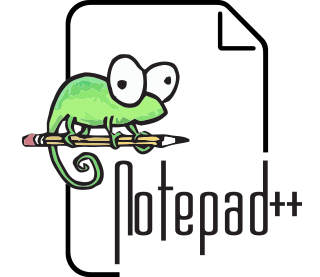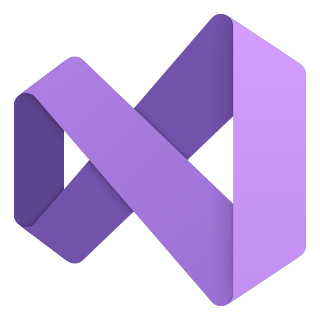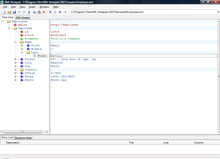
Microsoft XNA is a freeware set of tools with a managed runtime environment that Microsoft developed to facilitate video game development. XNA is based on .NET Framework, with versions that run on Windows and Xbox 360. XNA Game Studio can help develop XNA games. The XNA toolset was announced on March 24, 2004, at the Game Developers Conference in San Jose, California. A first Community Technology Preview of XNA Build was released on March 14, 2006.
Windows Installer XML Toolset, is a free software toolset that builds Windows Installer packages from XML. It consists of a command-line environment that developers may integrate into their build processes to build MSI and MSM packages. WiX was the first Microsoft project to be released under an open-source license, the Common Public License. It was also the first Microsoft project to be hosted on an external website.
IronPython is an implementation of the Python programming language targeting the .NET Framework and Mono. Jim Hugunin created the project and actively contributed to it up until Version 1.0 which was released on September 5, 2006. IronPython 2.0 was released on December 10, 2008. After version 1.0 it was maintained by a small team at Microsoft until the 2.7 Beta 1 release. Microsoft abandoned IronPython in late 2010, after which Hugunin left to work at Google. The project is currently maintained by a group of volunteers at GitHub. It is free and open-source software, and can be implemented with Python Tools for Visual Studio, which is a free and open-source extension for Microsoft's Visual Studio IDE.

Notepad++ is a free and open-source text and source code editor for use with Microsoft Windows. It supports tabbed editing, which allows working with multiple open files in a single window. The product's name comes from the C postfix increment operator.
A source-code-hosting facility is a file archive and web hosting facility for source code of software, documentation, web pages, and other works, accessible either publicly or privately. They are often used by open-source software projects and other multi-developer projects to maintain revision and version history, or version control. Many repositories provide a bug tracking system, and offer release management, mailing lists, and wiki-based project documentation. Software authors generally retain their copyright when software is posted to a code hosting facilities.
CodePlex was a forge website by Microsoft. While it was active, it allowed shared development of open-source software. Its features included wiki pages, source control based on Mercurial, TFVC, Subversion or Git, discussion forums, issue tracking, project tagging, RSS support, statistics, and releases.
The Microsoft Enterprise Library is a set of tools and programming libraries for the Microsoft .NET Framework. It provides APIs to facilitate proven practices in core areas of programming including data access, logging, exception handling and others. Enterprise Library is provided as pluggable binaries and source code, which can be freely used and customized by developers for their own purposes. It also ships with test cases and quickstarts.
Microsoft Build Engine, or MSBuild, is a set of free and open-source build tools for managed code under the Common Language Infrastructure as well as native C and C++ code. It was first released in 2003 and was a part of .NET Framework. MSBuild is included with Visual Studio, but can also be run independently through MSBuild's command-line interface.
Sandcastle is a documentation generator from Microsoft. It automatically produces MSDN-style code documentation out of reflection information of .NET assemblies and XML documentation comments found in the source code of these assemblies. It can also be used to produce user documentation from Microsoft Assistance Markup Language (MAML) with the same look and feel as reference documentation.
Entity Framework (EF) is an open source object–relational mapping (ORM) framework for ADO.NET. It was originally shipped as an integral part of .NET Framework, however starting with Entity Framework version 6.0 it has been delivered separately from the .NET Framework.
Azure DevOps Server is a Microsoft product that provides version control, reporting, requirements management, project management, automated builds, testing and release management capabilities. It covers the entire application lifecycle and enables DevOps capabilities. Azure DevOps can be used as a back-end to numerous integrated development environments (IDEs) but is tailored for Microsoft Visual Studio and Eclipse on all platforms.

Visual Studio is an integrated development environment (IDE) from Microsoft. It is used to develop computer programs including websites, web apps, web services and mobile apps. Visual Studio uses Microsoft software development platforms such as Windows API, Windows Forms, Windows Presentation Foundation, Windows Store and Microsoft Silverlight. It can produce both native code and managed code.
Family.Show is a free and open-source genealogy program written in C# and running on the .NET Framework. Microsoft partnered with and commissioned Vertigo Software in 2006 to create it as a reference application for Microsoft's latest UI technology and software deployment mechanism at the time, Windows Presentation Foundation and ClickOnce. The source code has originally been published on Microsoft's CodePlex website. It has since been forked and development continues independent of Microsoft on GitHub.
StyleCop is an open-source static code analysis tool from Microsoft that checks C# code for conformance to StyleCop's recommended coding styles and a subset of Microsoft's .NET Framework Design Guidelines. StyleCop analyses the source code, allowing it to enforce a different set of rules from FxCop. The rules are classified into the following categories:

Microsoft Small Basic is a programming language, interpreter and associated IDE. Microsoft's simplified variant of BASIC, it is designed to help students who have learnt visual programming languages such as Scratch learn text-based programming. The associated IDE provides a simplified programming environment with functionality such as syntax highlighting, intelligent code completion, and in-editor documentation access. The language has only 14 keywords.
Text Template Transformation Toolkit is a free and open-source template-based text generation framework. T4 source files are usually denoted by the file extension ".tt".

The .NET Framework is a proprietary software framework developed by Microsoft that runs primarily on Microsoft Windows. It was the predominant implementation of the Common Language Infrastructure (CLI) until being superseded by the cross-platform .NET project. It includes a large class library called Framework Class Library (FCL) and provides language interoperability across several programming languages. Programs written for .NET Framework execute in a software environment named the Common Language Runtime (CLR). The CLR is an application virtual machine that provides services such as security, memory management, and exception handling. As such, computer code written using .NET Framework is called "managed code". FCL and CLR together constitute the .NET Framework.
.NET Compiler Platform, also known by its codename Roslyn, is a set of open-source compilers and code analysis APIs for C# and Visual Basic (VB.NET) languages from Microsoft.
Microsoft, a technology company historically known for its opposition to the open source software paradigm, turned to embrace the approach in the 2010s. From the 1970s through 2000s under CEOs Bill Gates and Steve Ballmer, Microsoft viewed the community creation and sharing of communal code, later to be known as free and open source software, as a threat to its business, and both executives spoke negatively against it. In the 2010s, as the industry turned towards cloud, embedded, and mobile computing—technologies powered by open source advances—CEO Satya Nadella led Microsoft towards open source adoption although Microsoft's traditional Windows business continued to grow throughout this period generating revenues of 26.8 billion in the third quarter of 2018, while Microsoft's Azure cloud revenues nearly doubled.




